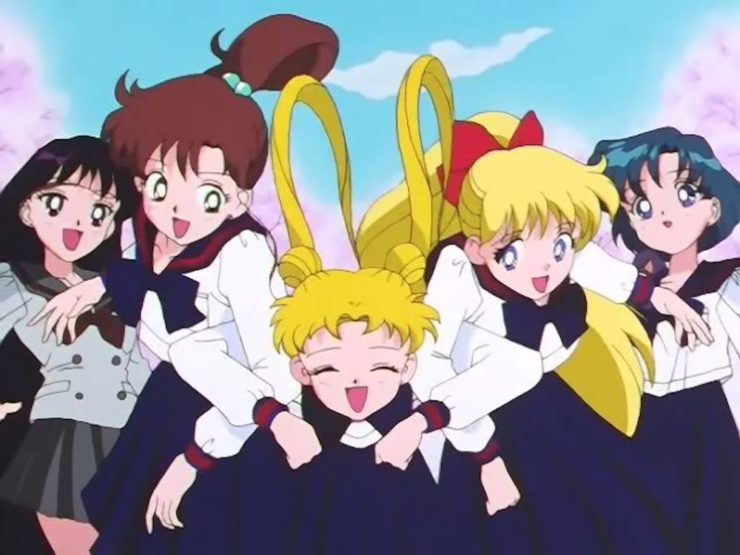On December 28, 1991, the magazine Nakayoshi ran the first chapter of the manga Sailor Moon, written and drawn by Naoko Takeuchi. About two months later, on March 7, 1992, the first episode of the anime Sailor Moon aired on TV Asahi. The series became an instant hit. The manga was a runaway bestseller in multiple languages and the anime aired in dozens of countries including (but not limited to) Japan, the United States, France, Spain, South Korea, the Philippines, Germany, and Italy.
At its core, Sailor Moon is the story of Usagi Tsukino, a clumsy fourteen-year-old girl. She meets a talking cat, Luna, who tells her that she is destined to fight evil as the legendary warrior Sailor Moon. As she embraces this destiny, Usagi meets her four friends and teammates: shy and bookish Ami Mizuno (Sailor Mercury), hot-headed priestess Rei Hino (Sailor Mars), bubbly aspiring pop idol Minako Aino (Sailor Venus), and the muscle of the group, the very feminine, extremely strong Makoto Kino (Sailor Jupiter). Together, the five young women battle villains and try to keep Earth safe while still dealing with the normal struggles and obligations of their daily lives.
Sailor Moon became a runaway hit, revolutionizing the magical girl genre as well as inspiring a legion of diehard fans—and one of those fans was my little eight-year-old self, who devoured the anime as it aired every day after school and bought the manga from Books-A-Million with whatever pocket money I could save. But thirty years later, how does the manga hold up? Plenty of properties lost their luster over time, or don’t age well for one reason or another. So, what about Sailor Moon?
I’m happy to report that, as a whole, I’d say that Sailor Moon still holds up well. The main draw of the series, the friendship between the five main female characters, feels as positive and relevant today as it did back in the 1990s—in fact, it arguably feels even more indispensable here in 2022. Take a look at the current best-selling manga titles and you will see very few series that feature multiple female main characters, let alone strong friendships between female main characters. Series like My Hero Academia, Demon Slayer, and Chainsaw Man will often only have one or two female characters among their main cast, with friendships between the female main characters and female supporting characters often sidelined. It’s refreshing to read a series that’s composed almost entirely of female characters portrayed with distinct personalities, likes, dislikes, and genuine friendships with each other.
Likewise, the portrayal of a lesbian relationship between two of the secondary characters remains as impactful today as it was in the 1990s. Sailor Moon has always had plenty of queer and LGBTQ+ fans, partly due to the relationship between Haruka Tenoh (Sailor Uranus) and Michiru Kaioh (Sailor Neptune). From their first appearance in the manga, Haruka and Michiru are portrayed as a healthy, loving couple. The two flirt with each other, teasing in the way that established couples do. They know each other’s quirks and support each other through thick and thin. Haruka and Michiru are seen as something to aspire to: our main characters idolize the two, regarding Haruka and Michiru as impressive, intensely beautiful and intensely talented. The narrative seems to share that view, often depicting the two with classic shoujo manga sparkles and flowers, a kind of shorthand to symbolize beauty. These characters read as cool, accomplished, impressive adults, even though they’re technically only a few years older than our main cast. And these cool impressive adults who the reader should look up to are also happily, openly, and unabashedly gay.
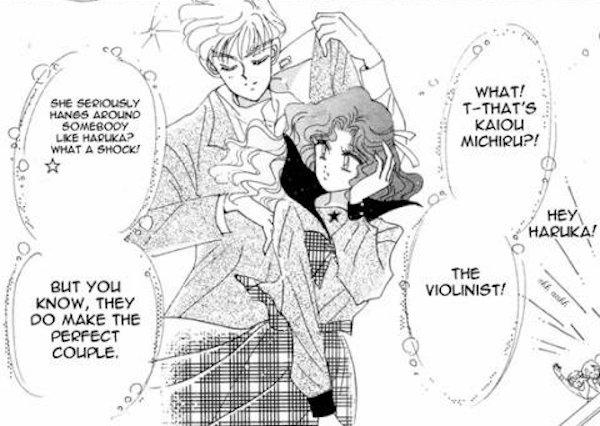
And then there are the Sailor Starlights. In the manga, the three characters (Seiya, Yaten, and Taiki Kou) are women who almost exclusively dress in a masculine style. One of them, Seiya, even has a low-key flirtation with Usagi. The anime does things a little differently. Possibly because of this element of flirtation in the manga, the anime decided that the Starlights were biologically male in their civilian identities but transformed to be biological women in their Sailor Scout forms. Was this a decision that caused a lot of discourse about the Starlights’ sexual and gender identity? Hoo boy yes. It doesn’t help that different dubs made differing decisions about how the Starlights identified. But what matters most, whether your version of the Starlights are trans, genderqueer, or female crossdressers, is that they are never, ever the butt of any joke. The Starlights serve as a strong presence for Usagi, aiding her in fighting evil as well as helping her deal with the drastic changes and traumatic events happening in her personal. In our present day, as legislators and school districts try to ban books with even a hint of LGBTQ+ content, LGBTQ+ content is sidelined, suppressed, and/or quickly edited out of blockbuster movies, and LGBTQ+ people are abused and attacked for simply existing, the story’s treatment of queer and gender nonconforming characters has only grown in importance and relevance.
Buy the Book
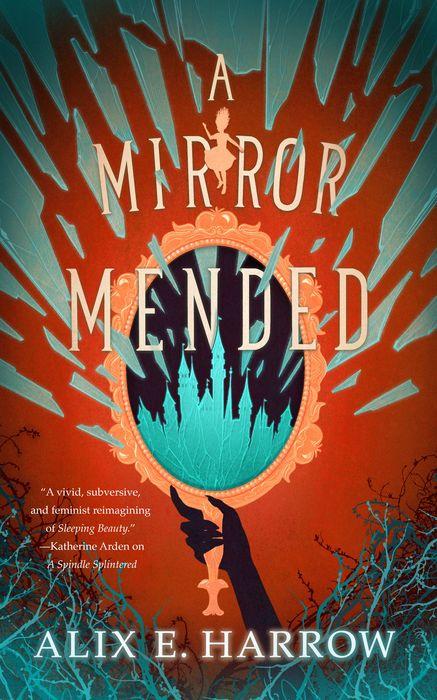

A Mirror Mended
Of course, there are some aspects of Sailor Moon which haven’t aged as well. In this age of increased focus on representing different types of body shapes and sizes in the media, it’s hard to miss the fact that each of the girls look like slender supermodels. In terms of antagonists, with a few exceptions, the supporting villains are one-note, often dispatched in the same chapter they were introduced, serving only as minor obstacles on the way to defeating the main villain… and then in turn defeating the actual final villain that’s been pulling the strings behind the scenes, which are often represented as some amorphous sinister force in comparison to the iconic character designs of the main villains. In all, the villains are easily one of the weakest links in the series.
There are also a few areas in which the anime was simply better than the manga. Due to the fact that the anime was published at the same time as the manga, these supporting villains were often turned into characters of their own, gaining personality traits, quirks, and relationships that did not exist in the manga. And for all the complaints that the anime was stuffed with filler (episodes that do nothing to move ahead the overarching plot), the filler did help define the personalities of Ami, Rei, Makoto, and Minako. The anime takes things at a slower and leisurely pace compared to the manga—the anime takes about 52 twenty-five minute episodes to complete an entire plot arc, while the manga takes about 14 forty page chapters. When the plot picks up and the story heads towards its climax, it’s easy for Usagi’s friends to get lost in the shuffle as the plot focuses on the thoughts and actions of Usagi herself. Each of her friends gets their moment in the sun, of course: each story arc features one or two chapters where the focus is solely on one of the members of the Inner Senshi, fleshing out their personality and their relationship with the rest of the team. But the filler episodes of the anime can take what was a page or two of character interactions in the manga and expand those beats into a series of small moments that give us real insight into the friendships at the heart of the story, spread over ten 20-minute episodes.
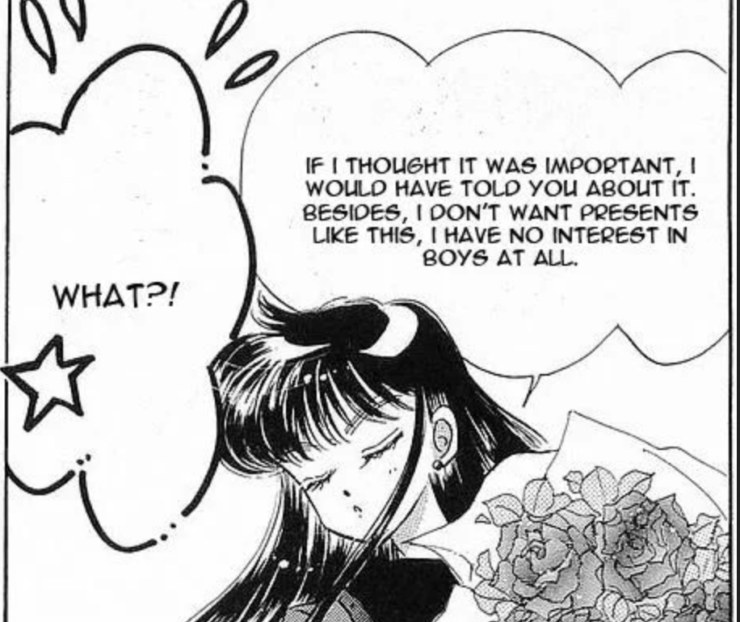
That being said, I’ve noticed that people’s hazy memories of the anime impacting their feelings of the manga can work both ways, with fans occasionally attributing the flaws of the anime to the manga. During my recent reread, I couldn’t help but notice how much more I loved Rei’s character in the manga compared to the anime. One of the main complaints the anime received is that the girls were all boy-crazy. And to an extent, it’s a fair criticism. Makoto, Minako, Rei, and Usagi would often develop a crush on whoever our attractive male victim of the day was—even after she got a steady boyfriend, Usagi was certainly not immune to the attractiveness of other men. But it should be noted that the Rei of the anime is practically a different person than the Rei of the manga: a graceful, yet headstrong young woman who doesn’t get the big deal about falling in love. Rei in the manga constantly rejects the advances of men, preferring to focus more on herself, her personal life, and her career instead of a boyfriend. She reiterates multiple times that she doesn’t have time for boys—she isn’t afraid of or dismissive towards romance, it simply isn’t her thing. Rei’s personality provides a wonderful contrast to the scared-of-romance Ami, the happily in love Usagi, and the boy-crazy Makoto and Minako. And it’s so refreshing to see a female character in a series targeted towards young girls who just does not give a damn about men—and who the narrative never punishes for having other priorities.
Another interesting trend I noticed while re-visiting Sailor Moon is the growth of the characters. Unlike other action heroes, the girls aren’t trapped in a perpetual adolescence. The series spans a period of approximately three to four years, with our main characters graduating from middle school and starting high school. As they grow older, their personalities mature. Usagi is often labeled as a crybaby and a whiner, crying and running away from danger to the annoyance of everyone else. But that trait is mainly in play at the start of the manga, when she still has that childish immaturity and is still very new to her life as a magical girl. As the story continues, Usagi grows up and is able to face danger head-on, without hesitation, as well as braving other more adult challenges such as depression and heartbreak.
In other cases, the characters grow up in a more physical sense: Chibi-Usa, Usagi’s daughter from the future, is functionally immortal, but grows from looking approximately five years old at her first appearance to looking fourteen or so at her final appearance, her personality maturing as well to match. There’s even one plot arc that explicitly underscores the fact that this is a series about growth and about character maturation. The SuperS arc features each Sailor Scout mulling over what to do in the future and what they want their adult lives to be like while they battle villainous children who literally regress Sailor Moon to a child for one chapter. As this is happening, Chibi-Usa also experiences a marker of maturity and growing up: her first love. This is a series that’s unafraid to age and mature with its viewers.
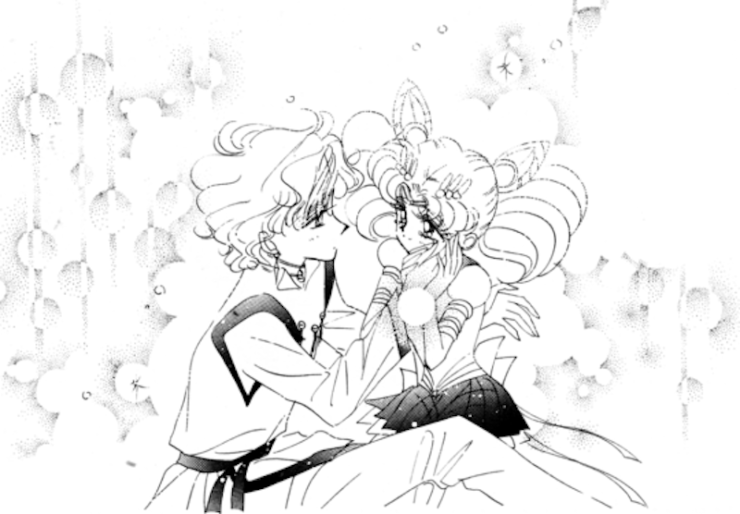
Perhaps that’s the reason why it ran for a short amount of time compared to other iconic series: Sailor Moon ran for 60 chapters and a handful of short stories and side chapters. In contrast, current popular series such as Demon Slayer and My Hero Academia have run for over 200 chapters. But if you were fourteen years old when the series started (the same age as Usagi was), you would be nineteen when the series ended—just a little bit older than Usagi at the series’ end, having grown up beside her every step of the way.
But no matter how old you were when it first came out, I recommend reading the manga because it’s simply a good story. It’s a delightfully romantic story—filled with challenges, heartbreak, and the wonders of young love—while simultaneously being a heart-pounding page-turner of an action story. All the major characters are well developed and compelling, pulling the reader in and holding their attention through any number of twists and turns. And, at twelve volumes, the manga is quite a bit shorter than a lot of other iconic series: long enough to tell a complete, satisfying story, but compact enough to read in a weekend. If you haven’t read Sailor Moon before, this anniversary is the perfect time to give it a shot.
Katie Gill (@katiebeluga) is a librarian by day, essayist by night. You can read her work at The Deadlands, Manor Vellum, and Anime Feminist and hear her voice on PseudoPod.










